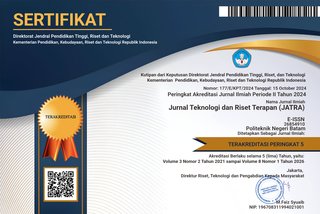Ship Recycling Rig Hibiscus Ditinjau Dari Sistem Manajemen Daur Ulang Ramah Lingkungan
DOI:
https://doi.org/10.30871/jatra.v5i1.5183Kata Kunci:
kapal, ship recycling, manajemen limbahAbstrak
Ship recycling dianggap sebagai alternatif terbaik yang digunakan untuk membuang kapal yang telah usang. Ship recycling merupakan kegiatan yang berhubungan dengan proses daur ulang kapal yaitu seperti penambatan/pengandasan kapal, pengambilan dan perbaikan material kapal. Keberadaan industri ship recycling di Indonesia diantaranya terdapat di Tanjung Jati (Madura), Cilincing (Jakarta Utara), Tenggamus (Lampung) serta Tanjung Uncang (Batam). Penelitian ini bertujuan untuk mengetahui proses ship recycling rig hibiscus yang dilakukan di PT. Batam Citra International, Tanjung Uncang Kota Batam. Berdasarkan hasil penelitian yang dilakukan, diperoleh bahwa proses ship recycling rig hibiscus dilakukan menggunakan rencana kerja cutting plan, dengan tahapan sebagai berikut : (1) Proses pra"“kedatangan di Sekupang anchorage, (2) Inspeksi bea cukai di Pelabuhan Sekupang, (3) Kapal ditarik dari Pelabuhan Sekupang ke dermaga PT. BES tempat berlabuh kapal, (4) Pemeriksaan umum oleh PT. BCI dan PT. BES, (5) Inspeksi badan lingkungan hidup lokal, (6) Penandaan IHM/ bahan berbahaya pada kapal, (7) Pemindahan bahan berbahaya maupun tidak berbahaya di dalam kapal, (8) Pemindahan Minyak dan barang yang mudah terbakar lainnya, (9) Pembersihan ruang mesin, (10) Ship recycling/ daur ulang kapal dimulai, (11) Tinjauan bulanan pembuangan limbah berbahaya, (12) Tinjauan insiden yang terjadi dan tindakan pencegahan yang diambil, (13) Hasil daur ulang kapal, dan yang terakhir, dan (14) Penyusunan laporan kepatuhan daur ulang kapal.
Unduhan
Referensi
Pengembangan Green Ship Recycling Yard di Indonesia, Tesis, ITS, Surabaya. https://repository.its.ac.id/3851/2/4115203007-Master-Theses.pdf
Mudgal, Shailendra et al. (2009), Feasibility Analysis Of Establishing A List Of Green and Safe Ship DismantlingFacilities.EuropeanComission.https://ec.europa.eu/environment/pdf/waste/ships/bio_shi p%20dismantling.pdf
Kristiyono, T.A., Basuki, M., dan Arifin, N.T. (2009), Studi Pengembangan Industri Dok dan Galangan Kapal di Daerah Paciran Lamongan, Teknik Perkapalan UHT, Surabaya. https://adoc.pub/download/studi-pengembangan-industri-dok-dan- galangan-kapal-di-daerah.html.
Amalia , Nidia. 2016. Analisis Teknis dan Ekonomis Pengembangan Industri Penutuhan Kapal Berwawasan Lingkungan di Pulau Madura. Tugas Akhir.Teknik Perkapalan ITS.
Fariya , Siti. 2016. Analisis Teknis Pengembangan Green Ship Recycling Yard di Indonesia. Thesis. Teknologi Produksi dan Material ITS.
Latif, Samsul. 2017. Analisa Teknis dan Ekonomis Pembangunan Galangan Kapal Untuk Produksi FPU (Floating Production Unit). Tugas Akhir. Teknik Perkapalan ITS.
Makbul, Amir. 2010. Techno Economy Study for Ship Recycling Yard Development In Indonesia. Thesis. Teknologi Produksi dan Material ITS.
Ariany, Zulfaidah . 2014. Kajian Reparasi Pengecatan Pada Lambung Kapal. Jurnal Teknik Universitas Diponegoro.
Falahudin. 2015. Perencanaan Slipway Pelabuhan Perikanan Samudera Nizam Zachman Jakarta. Jurnal Karya Teknik Sipil. Universitas Diponegoro.
Unduhan
Diterbitkan
Cara Mengutip
Terbitan
Bagian
Lisensi
Hak Cipta (c) 2023 Jurnal Teknologi dan Riset Terapan (JATRA)

Artikel ini berlisensiCreative Commons Attribution-NonCommercial-ShareAlike 4.0 International License.




11.jpg)











